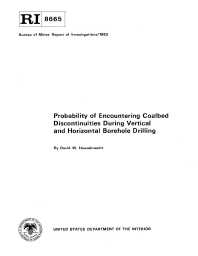Mining Publication: Probability of Encountering Coalbed Discontinuities During Vertical and Horizontal Borehole Drilling
Original creation date: January 1982
Probabilities of encountering coalbed discontinuities during vertical or horizontal drilling in a specific coalbed can be estimated based on analysis of mined-out areas of the coalbed where the size, shape, orientation, and distribution of discontinuities are known. The resultant probability estimates can be applied to cost-risk evaluations of drilling programs proposed for exploratory, developmental, or methane drainage purposes in undeveloped areas of that coalbed. Data compiled from mine maps of the Beckley Coalbed in southern West Virginia were used to estimate the probabilities that discontinuities would be encountered in two illustrative hypothetical drilling programs--one for drilling vertical boreholes and the other for drilling horizontal boreholes. Analysis based on a mined-out area of the Beckley coalbed indicated that vertical methane drainage boreholes spaced 1,000 feet apart in a square grid pattern would each have a 29-percent probability of encountering a discontinuity in a geologically unexplored area of the coalbed. It was also determined that exploratory vertical drilling could locate most of the discontinuities if a borehole spacing of 2,500 feet were used. For horizontal drainage boreholes in the Beckley coalbed, the analysis indicated a linear relationship between hole length and the probability of encountering a discontinuity.
Authors: DW Houseknecht
Report of Investigations - January 1982
NIOSHTIC2 Number: 10002361
Pittsburgh, PA: U.S. Department of the Interior, Bureau of Mines, RI 8665, 1982 Jan; :1-21
See Also
- Progress Toward Improved Engineering of Seals and Sealed Areas of Coal Mines
- Reducing Hazards in Underground Coal Mines Through the Recognition and Delineation of Coalbed Discontinuities Caused by Ancient Channel Processes
- Refuge Alternatives in Underground Coal Mines
- Rotary Drilling Holes in Coalbeds for Degasification
- Safe and Economical Inerting of Sealed Mine Areas
- SPONCOM - A Computer Program for the Prediction of the Spontaneous Combustion Potential of an Underground Coal Mine
- Technology News 535 - NIOSH Releases New Educational Video: Escape from Farmington No. 9: An Oral History
- Technology News 545 - NIOSH Updates Spontaneous Combustion Assessment Software
- Ultra-Low Frequency Through-the-Earth Communication Technology
- Wireless Mesh Mine Communication System
- Content source: National Institute for Occupational Safety and Health, Mining Program


 ShareCompartir
ShareCompartir
